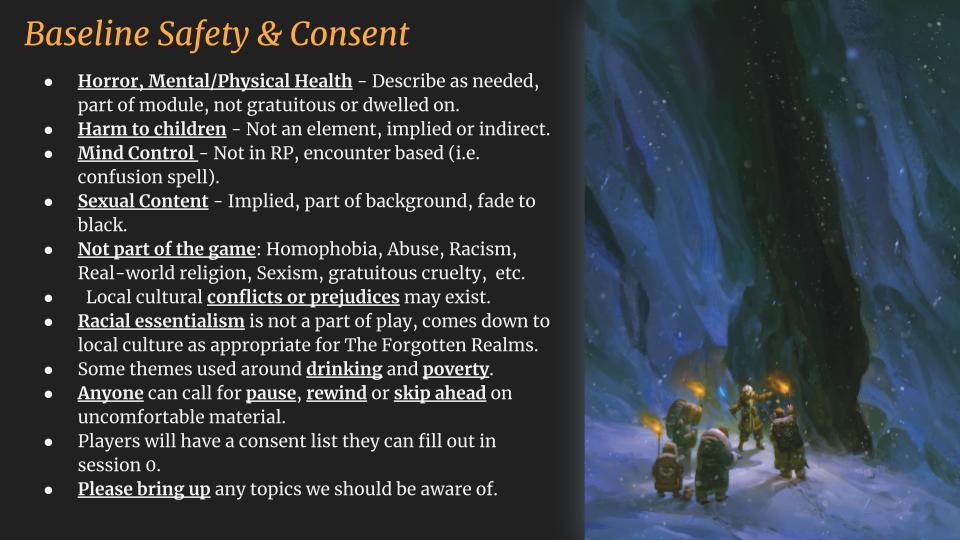
Safety & Consent RPG Checklist
Practical guidance and resources for using safety and consent tools in TTRPGs, from setting baselines to gathering player feedback for respectful play.
The development of safety tools has been one of the more useful advancements in Tabletop Roleplaying Games in the modern era. At their heart, these tools help groups normalize expectations, level set, and understand the range of issues a particular gaming group might experience. Firstly, these tools help people understand if a game is the right one for them. Secondly, it helps shape the conversation and understanding of how to deal with different topics in a way that honors the experiences and context of everyone at the table.
I first encountered a formalized approach to this with Consent in Gaming by Sean K. Reynolds & Shanna Germain, which provides a lot of excellent context on the topic. It got even more attention when Wizards of the Coast addressed some of these elements in Tasha's Caldron of everything, which is about as mainstream as you can get in the hobby.
The various tools let you uncover assumptions before the game, avoid issues when planning, and back out of uncomfortable situations during a session. This benefits everyone at the table, including the DM.
Some Resources#
Before I make a few short comments below, here are some resources you can use at your table.
- My Campaign Pitch Deck – This includes some examples of setting the stage for safety discussions PRIOR to session 0. (Free Google Slide)
- My Safety Checklist Form – This is another tool to use prior to session zero to shape the discussion. From the toolkit listed below. (Free Google Form) Update June 2021 - I changed the link to create an automatic copy of this document in your own account.
Great External Resources
- Consent in Gaming from MCG by Sean K. Reynolds & Shanna Germain
- TTRPG Saftey Toolkit Quick Reference by Kienna Shaw (Free PDF)
- X-Card System by John Stavropoulos, is a system for use during a session to back out of situations.
- Script Change RPG Toolbox by Beau Jágr Sheldon, is a great name-your-own-price resource for modifying things on the fly!
Put On Your Big Guy/Gal/Pal Pants#
The truth is, that as much attention as the topic has gotten in the last few years, we have a lot of work to do as a community on advocating for emotionally intelligent games. The negative online reaction to even the suggestion that Safety Tools could be useful is an excellent example of how far we have to go. I find this profoundly disappointing when it happens, as fostering a good conversation has to be our top priority. So even if you think there are people that aren't engaging in the topic of safety honestly, that doesn't give you carte blanche to discard the topic. We can't wait for the environment to be perfect before beginning to act with compassion and fostering safe and sane gaming community.
In short, even if this were true, even if you're the only adult in the room, it's still your responsibility to act like an adult.
Specific Advice and Tools#
I'll have to post more about this in the future, but I want to get some tools I've created for my own game in your hands in hopes this helps you with your games.
The reason this is so important now is that more new people are entering the hobby than ever before, and we are playing with new people in our groups all the time. Establishing clear a understanding of peoples ranges on issues is a pro-active means to avoid a world of hurt. It also helps you find the right group for your preferred genre and playstyle. There is no down-side to this.
Set The Baseline#
When I recruit for a campaign, work with a new group, introduce new members, or even introduce a new campaign to a group I know, I use a Baseline Safety & Consent list. I use this first, before I even survey the group for their own views. In this way I'm able to establish things we don't even have to discuss because I wont be making it part of my world as a DM. It also helps me establish lines with the players they shouldn't be planning to go past. In all honesty, I've had players in my game exceed my limits WAY more than I have exceeded theirs, and I am not a particularly squeamish guy. Trust me, if you are a DM, this is important for you and for your group.
By way of example, you can see the Baseline Safety & Consent slide from my most recent Campaign Pitch Deck below. I'll write a whole post on Pitch Decks some-day, but not to-day. Note this is a start of a conversation, not an end to one. I put these in a slide to get me to the next step of talking in depth about this with the players.

Get Group Feedback#
Okay, so having established your own ethical minimal viable product as a DM, it's time to get their input. This can be hard as we don't often talk about these topics in casual conversation. Many people find some kind of survey or form useful. So I created a Tabletop RPG Safety & Consent Checklist for use with my group. If you follow that link you can see it too and should be able to make a copy for modification and use in your own game. Drop me a DM on twitter if you have any trouble copying it and I'll do what I can to get you what you need.
Note, I did not invent this. The Checklist above is my modified version of the TTRPG Safety Toolkit I mentioned at the top of this post.
Now get out there and run some fun and safe games.
Drop a comment on X and let me know your thoughts!